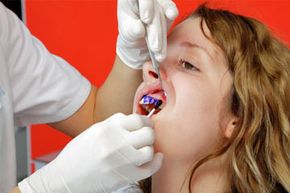A bubble-gum flavored polish with a fluoride treatment after has been pretty standard procedure for kids who visit the dentist, but how does this professional treatment work and what keeps it from just washing off the teeth? Can adults benefit from it, too? Whether it's painted on, swished around or even swallowed, fluoride is known to benefit the teeth, but before talking about what it does, what exactly is it?
Fluoride is a natural mineral that gets along really well with the mineral bonds in human teeth, or more specifically, with tooth enamel. Before fluoride is added to tooth products, it can be found in water, soil, air and rocks, among other places in nature. As part of an oral hygiene routine, it is very effective in fighting tooth decay and pain in decaying areas. It can stop and even reverse cavities, and it even helps remineralize tooth enamel, rebuilding bonds as they begin to wear away [sources: CDC; AAPD].
Advertisement
Drinking water and tooth products such as toothpastes and rinses are the most common sources of fluoride, but the most potent source is found only in the office of a dental professional. An in-office fluoride treatment involves applying a concentration not available over-the-counter (OTC), and it requires leaving the fluoride on the teeth to set into the enamel [source: JADA]. Most OTC tooth products contain fluoride, and the American Dental Association (ADA) recommends that we brush with fluoride toothpastes, but these pastes and gels stay on the teeth and in the mouth just a short time compared to those applied in a dental office.
If we're getting a daily dose of fluoride at home, either topically through brushing the outsides of our teeth or systemically by ingesting it in our water, is it necessary to get professional fluoride treatments? Or is that just kid stuff? We'll look at what the treatments are supposed to do next.
Advertisement


